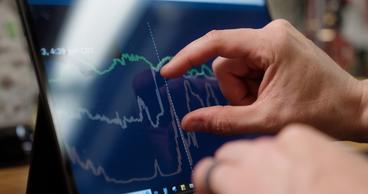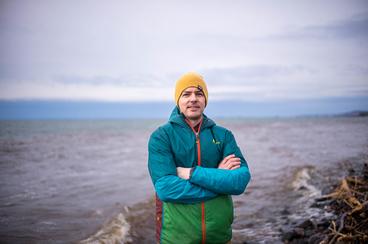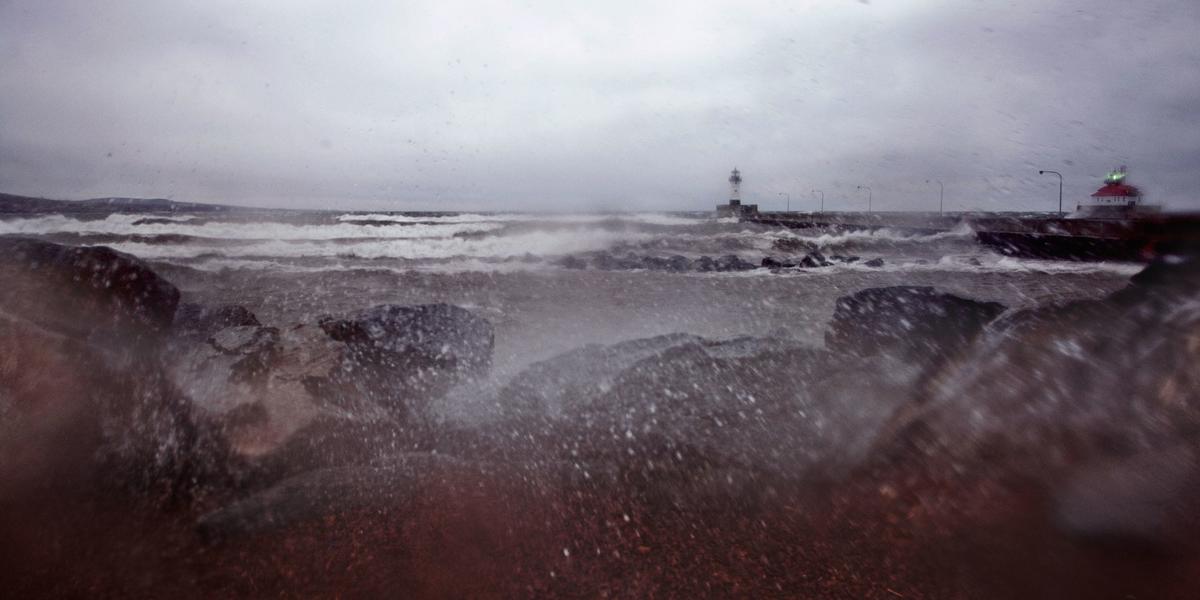Lake Superior’s gales of November are infamous for their ferocity and intensity, but when Craig Hill, PhD, an assistant professor at the University of Minnesota Duluth, looks out at the windswept torrent of waves crashing into his home port, he sees something most of us don’t: potential.
What are you doing through your research and what does that mean for our community?
My research focuses on the waves on Lake Superior and beyond to better understand how wave conditions are changing, and how coastal communities can better prepare for a future in which we may see more frequent events producing larger waves. This research includes exploring new methods to measure wave characteristics in real-time, how we could potentially harness some of that renewable energy to use for something else, and how we can make coastal communities more resilient to the extreme force of these waves on the shoreline.

How do Lake Superior waves impact Duluth?
Lake Superior influences every day here in Duluth, and its waves are just one part of that. These waves cause damage to infrastructure, create potentially dangerous swimming conditions, bring out freshwater surfers, impact fishing and other recreational activities, and can influence our Port activities. It is important to talk about the waves in detail to better inform our community about conditions, public safety concerns and to track changing conditions year-to-year. It is also exciting to think about these waves in new ways and the potential this region could play in emerging industries, not to mention that engaging with the data as impressive storms roll through the area is certainly awe inspiring!
What sort of power is in a Lake Superior storm and how do you measure it?
People might think about power in different ways. We see the destructive power of the waves when coastal infrastructure is damaged, but those same waves could be harnessed and converted into either mechanical or electrical energy. If we can measure the wave height and wave period (i.e. how many seconds there are between each passing wave), we can use this information to calculate how much power there is at any given moment, or how much total energy is available in the waves during storm events.
I could watch waves for hours. How about you!? Did you get out and watch the waves this past weekend? Ever wonder how much energy is in the waves on Lake Superior near Duluth? @UMNDuluth @UMDSwenson @MNSeaGrant #LakeSuperior #MarineRenewableEnergy pic.twitter.com/2fI9gE8oRP
— Craig Hill (@CraigHill_UMD) October 17, 2023
What would you like to see happen in the next 5-10 years?
This region has great potential to contribute to marine engineering industries, such as offshore wind and marine renewable energy. We have port infrastructure, a history of being an industrial city, and enthusiastic students to contribute to the future of these growing industries. We can use Lake Superior as a testing ground for new technologies, whether or not they find their permanent home in our waters. There is growing interest in the role the Great Lakes can play in these sustainable energy industries, and I am striving to have a small demonstration unit deployed in the next few years. My goal is to use it for advancing wave energy converter technology designs, controls and materials, while also engaging our community in the potential of this industry around the world.
How could that energy be used?
Energy from waves could power many industries around the world, and there’s a lot of interest in how it could support a variety of "blue industries," things like desalination equipment to produce fresh water; sensors for observation systems; remote communities that rely on other expensive forms of energy; recharging stations for boats and underwater vehicles; aquaculture industries; and so much more. But there’s also a future of looking at grid integrations to power homes and onshore industries. To put the power of those waves into perspective, imagine 4 foot tall waves on Lake Superior over the course of a day - certainly not uncommon for this time of year. In just a six-foot width of those 4 foot waves over 24 hours, there is technically enough energy to support six average Minnesota homes. So, the green energy potential in waves is amazing to think about, and it’s something that really motivates me to keep working toward those solutions.
About Craig

Craig Hill, PhD, is an assistant professor of mechanical and industrial engineering in the Swenson College of Science and Engineering at the University of Minnesota Duluth. He is an affiliate faculty member with the UMD Large Lakes Observatory, UMN Water Resources Science Graduate Degree Program, and the UMN Institute on the Environment. His research interests span the intersection between marine environments and engineered systems. He focuses on identifying new technologies to aid in society’s transition towards sustainable energy, smart environments, and resilient coastal communities. His research explores new real-time observation platforms for marine and atmospheric monitoring, fluid-structure interactions of marine and wind energy technologies, wave climate and coastal impacts in the Great Lakes, and opportunities for marine energy technologies to power blue economic industries. He is particularly interested in connecting students and the community with the Great Lakes environment, sustainable energy systems, and Duluth’s unique and vibrant maritime industry on Lake Superior.
